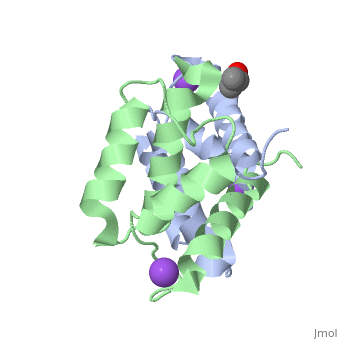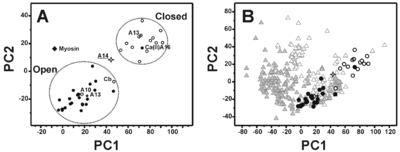S100 protein
From Proteopedia
(Difference between revisions)
| Line 29: | Line 29: | ||
S100A16 is a special member of the S100 class of calcium binding proteins, because it <scene name='Journal:JBIC:3/As/12'>performs a conformational change upon calcium(II) binding</scene> much smaller than experienced by most S100 proteins. This was observed after determination of the solution structures of apo and <scene name='Journal:JBIC:3/Dual_binding_calcium/3'>calcium(II)-bound S100A16</scene> and the <scene name='Journal:JBIC:3/Crysal/2'>crystal structure of apo S100A16</scene>. The likely reason for minimal conformational change <scene name='Journal:JBIC:3/Calcium_binding_start/7'>in S100A16</scene> is the lower calcium binding affinity and stronger <scene name='Journal:JBIC:3/Hydrophobic_interactions_2/3'>hydrophobic interaction</scene> between <scene name='Journal:JBIC:3/Please_work/3'>helix III and IV present in this protein </scene> with respect to other S100 proteins. Another characteristic of <scene name='Journal:JBIC:3/Opening/3'>S100A16</scene> is that the helix IV has the same length in <scene name='Journal:JBIC:3/25_residue_long_apo/3'>both apo</scene> and <scene name='Journal:JBIC:3/25_residue_calclium_bound/3'>calcium(II) forms</scene> because of <scene name='Journal:JBIC:3/Motif_good/5'>the presence of a Gly-Gly-Ile-Thr-Gly-Pro sequence motif</scene> in helix IV. Based on the available structures of S100 members, we analyzed and summarized all their conformational changes due to calcium(II) binding by a principal component analysis. <scene name='Journal:JBIC:3/Calcium_binding_start/7'>Calcium binding</scene> was proved by both NMR titration and Isothermal Titration Calorimetry (ITC) experiments. Even if the <scene name='Journal:JBIC:3/Binding_calcium_glu/2'>important Glu residue</scene> in the last position of first EF-hand calcium binding loop <scene name='Journal:JBIC:3/Binding_calcium/13'>is missing</scene>, these experimental data indicated that S100A16 can still bind one calcium(II) ion in such loop. NMR relaxation <scene name='Journal:JBIC:3/Flexible_broadwide/4'>studies showed that the first calcium binding loop and the beginning of the second helix</scene> are the most <scene name='Journal:JBIC:3/Flexible_broad/3'>flexible regions in both the apo and calcium(II)-bound S100A16</scene>. Although the biological function of S100A16 is still unclear yet, these structural and dynamic properties can provide useful information for further functional studies. | S100A16 is a special member of the S100 class of calcium binding proteins, because it <scene name='Journal:JBIC:3/As/12'>performs a conformational change upon calcium(II) binding</scene> much smaller than experienced by most S100 proteins. This was observed after determination of the solution structures of apo and <scene name='Journal:JBIC:3/Dual_binding_calcium/3'>calcium(II)-bound S100A16</scene> and the <scene name='Journal:JBIC:3/Crysal/2'>crystal structure of apo S100A16</scene>. The likely reason for minimal conformational change <scene name='Journal:JBIC:3/Calcium_binding_start/7'>in S100A16</scene> is the lower calcium binding affinity and stronger <scene name='Journal:JBIC:3/Hydrophobic_interactions_2/3'>hydrophobic interaction</scene> between <scene name='Journal:JBIC:3/Please_work/3'>helix III and IV present in this protein </scene> with respect to other S100 proteins. Another characteristic of <scene name='Journal:JBIC:3/Opening/3'>S100A16</scene> is that the helix IV has the same length in <scene name='Journal:JBIC:3/25_residue_long_apo/3'>both apo</scene> and <scene name='Journal:JBIC:3/25_residue_calclium_bound/3'>calcium(II) forms</scene> because of <scene name='Journal:JBIC:3/Motif_good/5'>the presence of a Gly-Gly-Ile-Thr-Gly-Pro sequence motif</scene> in helix IV. Based on the available structures of S100 members, we analyzed and summarized all their conformational changes due to calcium(II) binding by a principal component analysis. <scene name='Journal:JBIC:3/Calcium_binding_start/7'>Calcium binding</scene> was proved by both NMR titration and Isothermal Titration Calorimetry (ITC) experiments. Even if the <scene name='Journal:JBIC:3/Binding_calcium_glu/2'>important Glu residue</scene> in the last position of first EF-hand calcium binding loop <scene name='Journal:JBIC:3/Binding_calcium/13'>is missing</scene>, these experimental data indicated that S100A16 can still bind one calcium(II) ion in such loop. NMR relaxation <scene name='Journal:JBIC:3/Flexible_broadwide/4'>studies showed that the first calcium binding loop and the beginning of the second helix</scene> are the most <scene name='Journal:JBIC:3/Flexible_broad/3'>flexible regions in both the apo and calcium(II)-bound S100A16</scene>. Although the biological function of S100A16 is still unclear yet, these structural and dynamic properties can provide useful information for further functional studies. | ||
| + | |||
| + | == 3D Structures of S100 proteins == | ||
| + | [[S100 proteins 3D structures]] | ||
| + | |||
</StructureSection> | </StructureSection> | ||
== 3D Structures of S100 proteins == | == 3D Structures of S100 proteins == | ||
| Line 37: | Line 41: | ||
*S100-A1 | *S100-A1 | ||
| - | **[[1k2h]] – rCBP-1 – rat - NMR <br /> | ||
| - | **[[2k2f]] – rCBP-1 + Ca + ryanodine receptor peptide - NMR<br /> | ||
| - | **[[2kbm]] – rCBP-1 + F-actin capping protein peptide - NMR<br /> | ||
**[[1zfs]], [[2lp2]], [[2lp3]], [[2l0p]] – hCBP-1 + Ca – human - NMR<br /> | **[[1zfs]], [[2lp2]], [[2lp3]], [[2l0p]] – hCBP-1 + Ca – human - NMR<br /> | ||
**[[5k89]] – hCBP-1 + Ca <br /> | **[[5k89]] – hCBP-1 + Ca <br /> | ||
| Line 46: | Line 47: | ||
**[[2llt]], [[2llu]] – hCBP-1 - NMR<br /> | **[[2llt]], [[2llu]] – hCBP-1 - NMR<br /> | ||
**[[2jpt]] – bCBP-1 (mutant) – bovine - NMR <br /> | **[[2jpt]] – bCBP-1 (mutant) – bovine - NMR <br /> | ||
| + | **[[1k2h]] – rCBP-1 – rat - NMR <br /> | ||
| + | **[[2k2f]] – rCBP-1 + Ca + ryanodine receptor peptide - NMR<br /> | ||
| + | **[[2kbm]] – rCBP-1 + F-actin capping protein peptide - NMR<br /> | ||
*S100-A2 | *S100-A2 | ||
| Line 76: | Line 80: | ||
*S100-A6 (Calcyclin) | *S100-A6 (Calcyclin) | ||
| - | **[[1cnp]], [[1a03]], [[2cnp]], [[1jwd]] – raCBP-6 – rabbit - NMR<br /> | ||
| - | **[[2jtt]] – raCBP-6 + calcyclin-binding protein - NMR<br /> | ||
**[[1kso]], [[1k8u]], [[1k9p]] – hCBP-6 <br /> | **[[1kso]], [[1k8u]], [[1k9p]] – hCBP-6 <br /> | ||
**[[1k96]], [[1k9k]] – hCBP-6 + Ca <br /> | **[[1k96]], [[1k9k]] – hCBP-6 + Ca <br /> | ||
**[[2m1k]] – hCBP-6 (mutant) + RAGE receptor - NMR <br /> | **[[2m1k]] – hCBP-6 (mutant) + RAGE receptor - NMR <br /> | ||
**[[4p2y]], [[4ybh]] – hCBP-6 + RAGE receptor + Ca + Zn <br /> | **[[4p2y]], [[4ybh]] – hCBP-6 + RAGE receptor + Ca + Zn <br /> | ||
| + | **[[1cnp]], [[1a03]], [[2cnp]], [[1jwd]] – raCBP-6 – rabbit - NMR<br /> | ||
| + | **[[2jtt]] – raCBP-6 + calcyclin-binding protein - NMR<br /> | ||
*S100-A7 (Psoriasin) | *S100-A7 (Psoriasin) | ||
| Line 98: | Line 102: | ||
**[[5w1f]] – hCBP-8 (mutant) + hCBP-9 (mutant) + Ni + Ca <br /> | **[[5w1f]] – hCBP-8 (mutant) + hCBP-9 (mutant) + Ni + Ca <br /> | ||
**[[4xjk]] – hCBP-8 (mutant) + hCBP-9 (mutant) + Ca + Mn <br /> | **[[4xjk]] – hCBP-8 (mutant) + hCBP-9 (mutant) + Ca + Mn <br /> | ||
| - | |||
*S100-A9 (Calgranulin-B or Migration inhibitory factor-related protein 14) | *S100-A9 (Calgranulin-B or Migration inhibitory factor-related protein 14) | ||
| Line 122: | Line 125: | ||
*S100-A11 (Calgizzarin) | *S100-A11 (Calgizzarin) | ||
| - | **[[1qls]] – CBP-11 + Ca + annexin I - pig <br /> | ||
| - | **[[1nsh]] – raCBP-11 - NMR<br /> | ||
**[[2luc]] – hCBP-11 - NMR<br /> | **[[2luc]] – hCBP-11 - NMR<br /> | ||
**[[1v4z]], [[1v50]] – hCBP-11 N terminal - NMR<br /> | **[[1v4z]], [[1v50]] – hCBP-11 N terminal - NMR<br /> | ||
| + | **[[1qls]] – pCBP-11 + Ca + annexin I - pig <br /> | ||
| + | **[[1nsh]] – raCBP-11 - NMR<br /> | ||
*S100-A12 | *S100-A12 | ||
| Line 138: | Line 141: | ||
*S100-A13 | *S100-A13 | ||
| - | **[[2cxj]] – CBP-13 – mouse - NMR<br /> | ||
**[[1yur]], [[1yus]] – hCBP-13 - NMR<br /> | **[[1yur]], [[1yus]] – hCBP-13 - NMR<br /> | ||
**[[1yut]], [[1yuu]] – hCBP-13 + Ca - NMR<br /> | **[[1yut]], [[1yuu]] – hCBP-13 + Ca - NMR<br /> | ||
| Line 148: | Line 150: | ||
**[[2le9]] – hCBP-13 + RAGEC2 - NMR<br /> | **[[2le9]] – hCBP-13 + RAGEC2 - NMR<br /> | ||
**[[2kot]] – hCBP-13 + amlexanox - NMR<br /> | **[[2kot]] – hCBP-13 + amlexanox - NMR<br /> | ||
| + | **[[2cxj]] – CBP-13 – mouse - NMR<br /> | ||
*S100-A14 | *S100-A14 | ||
| Line 165: | Line 168: | ||
*S100B | *S100B | ||
| - | **[[1sym]], [[1b4c]] – rCBP – rat - NMR<br /> | ||
| - | **[[1qlk]], [[2k7o]] – rCBP + Ca - NMR<br /> | ||
| - | **[[1xyd]] – rCBP + Zn + Ca - NMR<br /> | ||
| - | **[[1dt7]] – rCBP + Ca + p53 peptide - NMR<br /> | ||
| - | **[[1mwn]] – rCBP + F-actin capping protein peptide - NMR<br /> | ||
**[[1mq1]] – hCBP + F-actin capping protein peptide - NMR<br /> | **[[1mq1]] – hCBP + F-actin capping protein peptide - NMR<br /> | ||
| + | **[[1uwo]], [[2pru]] – hCBP - NMR <br /> | ||
| + | **[[2h61]], [[3hcm]] – hCBP + Ca <br /> | ||
| + | **[[4xyn]], [[5d7f]] – hCBP + Ca + RAGE peptide <br /> | ||
| + | **[[3czt]], [[3d0y]], [[3d10]] – hCBP + Zn + Ca <br /> | ||
| + | **[[2m49]] – hCBP + fibroblast growth factor 2 - NMR<br /> | ||
| + | **[[5csi]], [[5csj]], [[5csn]], [[5csf]] – hCBP subunit β + ribosomal protein S6 kinase α-1 peptide + Ca <br /> | ||
**[[3rm1]] – bCBP + F-actin capping protein peptide + Ca<br /> | **[[3rm1]] – bCBP + F-actin capping protein peptide + Ca<br /> | ||
**[[1psb]] – bCBP + NDR kinase peptide - NMR<br /> | **[[1psb]] – bCBP + NDR kinase peptide - NMR<br /> | ||
| Line 179: | Line 183: | ||
**[[4pdz]], [[4pe0]], [[4pe1]], [[4pe4]], [[4pe7]], [[5dkn]], [[5dkq]], [[5dkr]], [[5er4]], [[5er5]] – bCBP + Ca + inhibitor<br /> | **[[4pdz]], [[4pe0]], [[4pe1]], [[4pe4]], [[4pe7]], [[5dkn]], [[5dkq]], [[5dkr]], [[5er4]], [[5er5]] – bCBP + Ca + inhibitor<br /> | ||
**[[4fqo]] – bCBP (mutant) + Ca + inhibitor<br /> | **[[4fqo]] – bCBP (mutant) + Ca + inhibitor<br /> | ||
| - | **[[ | + | **[[1sym]], [[1b4c]] – rCBP – rat - NMR<br /> |
| - | **[[ | + | **[[1qlk]], [[2k7o]] – rCBP + Ca - NMR<br /> |
| - | + | **[[1xyd]] – rCBP + Zn + Ca - NMR<br /> | |
| - | **[[ | + | **[[1dt7]] – rCBP + Ca + p53 peptide - NMR<br /> |
| - | **[[ | + | **[[1mwn]] – rCBP + F-actin capping protein peptide - NMR<br /> |
| - | **[[ | + | |
*Calbindin D9k (S100G) | *Calbindin D9k (S100G) | ||
Revision as of 11:48, 31 December 2019
| |||||||||||
3D Structures of S100 proteins
Updated on 31-December-2019
References
- ↑ Donato R, Cannon BR, Sorci G, Riuzzi F, Hsu K, Weber DJ, Geczy CL. Functions of S100 proteins. Curr Mol Med. 2013 Jan;13(1):24-57. PMID:22834835
- ↑ Yao R, Lopez-Beltran A, Maclennan GT, Montironi R, Eble JN, Cheng L. Expression of S100 protein family members in the pathogenesis of bladder tumors. Anticancer Res. 2007 Sep-Oct;27(5A):3051-8. PMID:17970044
- ↑ Wilsmann-Theis D, Wagenpfeil J, Holzinger D, Roth J, Koch S, Schnautz S, Bieber T, Wenzel J. Among the S100 proteins, S100A12 is the most significant marker for psoriasis disease activity. J Eur Acad Dermatol Venereol. 2016 Jul;30(7):1165-70. doi: 10.1111/jdv.13269., Epub 2015 Sep 2. PMID:26333514 doi:http://dx.doi.org/10.1111/jdv.13269
- ↑ Zhu L, Okano S, Takahara M, Chiba T, Tu Y, Oda Y, Furue M. Expression of S100 protein family members in normal skin and sweat gland tumors. J Dermatol Sci. 2013 Jun;70(3):211-9. doi: 10.1016/j.jdermsci.2013.03.002. Epub, 2013 Mar 16. PMID:23623205 doi:http://dx.doi.org/10.1016/j.jdermsci.2013.03.002
- ↑ Bertini I, Borsi V, Cerofolini L, Das Gupta S, Fragai M, Luchinat C. Solution structure and dynamics of human S100A14. J Biol Inorg Chem. 2012 Nov 30. PMID:23197251 doi:10.1007/s00775-012-0963-3
- ↑ Babini E, Bertini I, Borsi V, Calderone V, Hu X, Luchinat C, Parigi G. Structural characterization of human S100A16, a low-affinity calcium binder. J Biol Inorg Chem. 2010 Nov 3. PMID:21046186 doi:10.1007/s00775-010-0721-3


